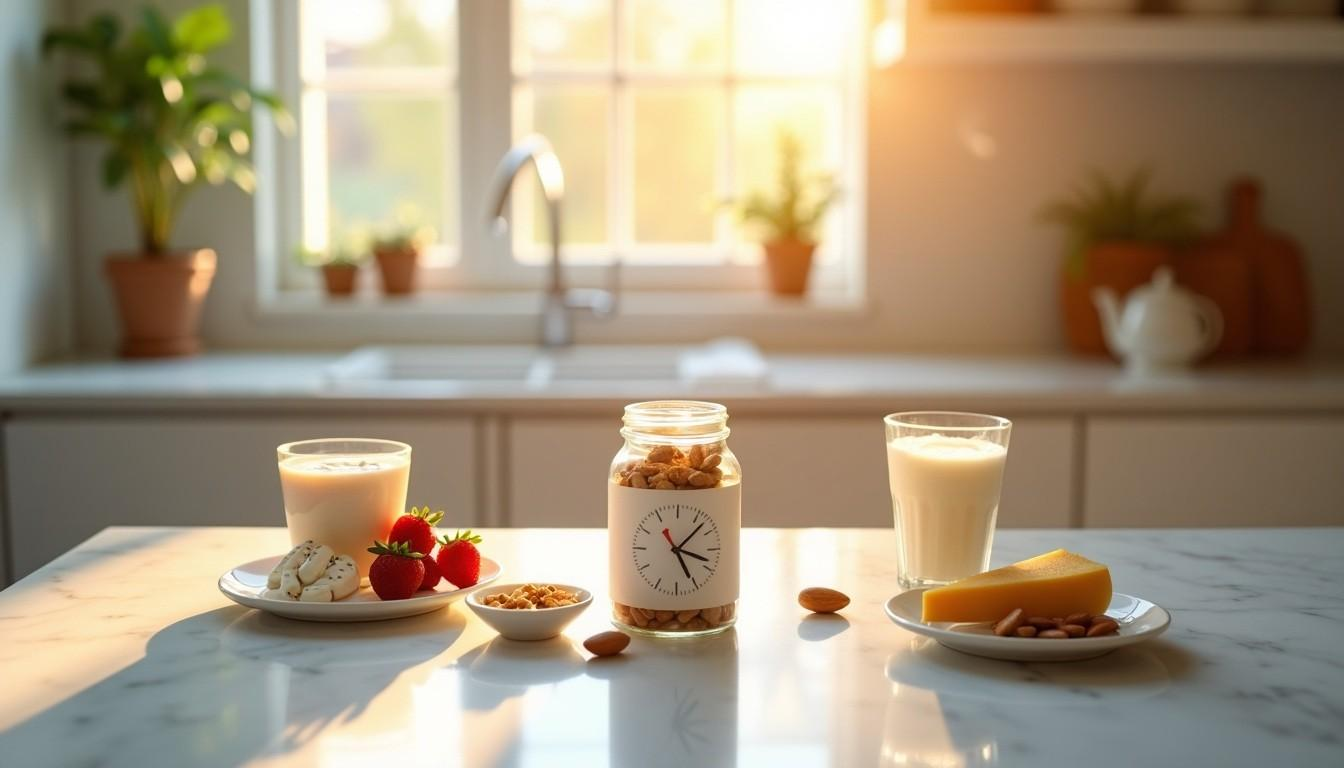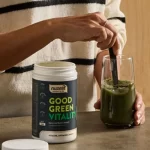

Probiotic intake is vital for getting the best health benefits,these helpful bacteria boost digestive health, strengthen immunity, and can improve sleep quality. Their success depends on how and when you take them. Research shows these supplements work best when at least 100 million to 1 billion living microorganisms reach your intestine. The survival rate and effectiveness of these beneficial bacteria substantially improve if you take them before meals, with foods containing small amounts of fat, or on an empty stomach.
This piece breaks down the best times to take probiotics – morning versus night – and explains how your food choices and stomach acid levels affect their strength.
The best time to take probiotics remains a hot topic that splits both experts and consumers. The timing of your probiotic intake might affect how well these good bacteria settle in your gut.
Most health experts suggest taking probiotics first thing in the morning before eating anything. Your stomach acid levels stay calmer in the morning, which helps probiotic bacteria move through your digestive system easily [1]. Studies show that Lactobacillus and Bifidobacterium strains survive best when you take them up to 30 minutes before meals [2].
Scientists found that probiotics had the highest survival rates when people took them either with food or 30 minutes before eating [2]. Their research showed that “non-enteric coated bacterial probiotic products should be taken with or just prior to a meal containing some fats” [2]. Taking probiotics with breakfast might create the perfect environment for them to work.
In spite of that, studies that looked at how probiotics settle in the gut found timing didn’t affect their benefits much [3]. Sticking to a regular schedule matters more than the exact time you take them.
Nighttime probiotic intake comes with unique advantages. Your digestive system stays active while you sleep, with fewer food-related disruptions that could affect how probiotics move through [1]. This nighttime activity lets probiotics work better throughout your system.
Some probiotic strains can help calm your nervous system and might help you sleep better [1]. A study of stressed college students showed better sleep quality after they took probiotics for 11 weeks [4]. Research also found links between better sleep scores and probiotic use through self-reported surveys [4].
Taking probiotics at night means food won’t get in their way as they move through your digestive system [1]. This clear path might help your body absorb and use these good bacteria better.
Your body’s internal clock plays a key role in how well probiotics work. This clock syncs your behaviour and body functions with regular patterns in sleep-wake cycles and eating times [5]. Bacteria produce substances that follow rhythmic patterns and can control your body’s daily rhythms and metabolism [5].
Scientists discovered a two-way relationship between your daily rhythm and gut bacteria. These bacteria follow daily patterns, and studies show that removing gut bacteria disrupts the normal gene patterns in your digestive system [5].
Changes in when you eat can throw these natural rhythms off balance. Your eating habits can affect your gut bacteria’s biological clock [5]. This works both ways— your daily rhythm affects your gut bacteria’s makeup and function, but your body clock also needs these bacteria’s daily changes to work properly [5].
Probiotics might help keep these rhythms in check. Some research hints they can improve sleep disorders tied to circadian rhythm by working through the microbiome-gut-brain axis [5].
The stomach creates a tough environment for probiotic bacteria that need to reach the intestines to thrive. Your choice to take probiotics with or without food can affect how well they survive their trip through your digestive system.
Taking probiotics on an empty stomach gives bacteria a better chance at survival. Your stomach produces less acid at these times, which makes it easier for probiotic microorganisms to survive [6]. On top of that, it takes less time for bacteria to pass through an empty stomach, so they can reach the intestines faster and start to grow [6].
Studies show that some probiotic strains, especially Lactobacillus and Bifidobacterium, do better when you take them about 30 minutes before eating [7]. This timing helps them avoid stomach acid but gives them enough time to pass through before your body starts producing digestive juices [7].
But this method isn’t perfect. Your stomach stays acidic even when it’s empty, and the pH levels can still harm many probiotic strains [8]. Food actually helps protect probiotics by creating a barrier against harsh stomach conditions [9].
The best time to take probiotics depends on the bacterial strains in your supplement and how they’re made. Some companies make their products to work without food, while others want you to take them with meals [10].
Probiotic bacteria handle stomach acid differently. Lactobacillus species are tougher than other bacteria groups and survive acid better, which makes them great probiotics [8]. These bacteria adapted over time—many Lactobacillus strains come from the human gut, so they naturally resist stomach acid [11].
Lactobacillus gasseri OLL2716 (LG21) is one of the toughest strains. It can survive at pH 2.5, which is close to your stomach’s natural acidity [8]. Lactobacillus acidophilus Rosell-52 and Lactobacillus rhamnosus Rosell-11 also survive well, even with antibiotics [12].
Most bifidobacteria don’t handle acid well, but there are exceptions. Bifidobacterium lactis, Bifidobacterium animalis, and BB-12 ® stand out. BB-12 ® stays 60-80% alive when passing through conditions that mimic the stomach [13].
Saccharomyces boulardii, a helpful yeast, survives just as well with or without food [11]. This makes it a flexible choice for any supplement schedule.
The way probiotics are packaged matters too. Capsules, tablets, and beads protect bacteria better than powders or liquids [11]. Some companies use special coatings or time-release technology to shield probiotics from stomach acid, though these methods aren’t perfect [12].
You’ll get the best results by choosing products with acid-resistant strains or protective packaging. These will deliver live probiotics to your intestines whether you take them with food or not.
What you eat with your probiotic supplement can make a big difference in how well it works. Studies show that some foods can help or hurt the survival of beneficial bacteria as they move through your digestive system.
Fat shields probiotic bacteria from harsh stomach acids. A study showed that probiotics survived better when people took them with meals that had small amounts of fat [1]. Scientists found that “ideally, non-enteric coated bacterial probiotic products should be taken with or just prior to a meal containing some fats” [14].
This protection works in two ways. Fat slows down how fast probiotics move through your stomach, which might surprise you. The fat also raises the stomach’s pH level, making it less acidic [1]. These effects help more good bacteria reach your intestines safely.
Research shows that a meal’s fat content matters more than its protein content for bacteria survival [14]. That’s why low-fat milk (with just 1% fat) helped protect probiotics better than water or apple juice in clinical studies [11].
Some foods are really good at helping probiotics survive:
Dairy products: Microorganisms survived better when people took supplements with low-fat milk instead of water or juice [11]. Yoghurt with live cultures makes a natural home for probiotics [15].
Oatmeal: Probiotics lasted longer when taken with cooked oatmeal mixed with milk [14].
Honey: Clover honey helps probiotics survive the intestinal phase of digestion [15]. Studies found that mixing one tablespoon of honey with yoghurt kept the most probiotics alive [15].
Timing matters too. The best results come from taking probiotics 30 minutes before eating or during meals, rather than waiting until after [1].
Some foods can actually hurt your probiotics by throwing off gut flora balance or killing good bacteria:
Check your probiotic product’s label instructions since different brands work differently [1]. Some bacterial strains (Saccharomyces boulardii) resist stomach acid better and work well with meals – sometimes even multiple times daily [18].
Your probiotic schedule can work better when you match it to your health needs. The right timing makes a big difference, and some health conditions need special approaches.
Sticking to a regular schedule matters more than exact timing for digestive problems. If you have constipation, take products with Bifidobacterium lactis daily for at least four weeks to see if they work [19]. You should try a different brand or stop using them if you don’t see results [4].
Probiotics might help if you don’t deal very well with irritable bowel syndrome (IBS). Some strains work well to reduce symptoms, especially when you have bloating [4]. People with inflammatory bowel conditions like ulcerative colitis can stay in remission by taking probiotics regularly [4].
The key is to build a routine. Taking your probiotic supplement at the same time each day will give a steady supply of good bacteria. This helps whether you’re dealing with constipation, diarrhoea, or just general digestive issues [20].
A healthy gut microbiome boosts your immunity and reduces inflammation by a lot [19]. Taking probiotics 30 minutes before breakfast helps them reach your intestines better, which is great for immune support [18].
Regular probiotic use helps your immune system curb infections better. Studies show they can make colds shorter and boost how well some vaccines work [4]. You need to take them daily because probiotics don’t stay in your system permanently [20].
Timing becomes extra important when you’re on antibiotics. Here’s what research shows:
Kids who start probiotics within 24 hours of antibiotic treatment have 35% less risk of diarrhoea. Older adults who start within 48 hours see their risk drop by 29%[21]. Of course, starting after 48 hours still helps restore gut balance, but it’s nowhere near as good at preventing diarrhoea [21].
Quality probiotics with proven strains at the right doses are vital for recovery. Clinical trials show Lactobacillus rhamnosus GG, Bifidobacterium animalis lactis (BB12 ®), and Saccharomyces boulardii work really well [5].
A customised probiotic regimen can substantially improve your results. Research shows that taking probiotics consistently matters more than perfect timing. Studies reveal that probiotics don’t create permanent microbiome changes [20]. You need regular intake to maintain the benefits.
Pick a time you won’t forget. Research shows that taking probiotics at the same time daily will give beneficial microorganisms their best chance to thrive [18]. Morning works well for many people. Studies show your stomach acid levels are lower then [23]. This helps more bacteria survive.
Bedtime has its advantages too. Your gut stays active during sleep, which lets probiotics work with fewer interruptions [24]. The most effective schedule is one you can stick to reliably. As one specialist puts it, “The one important thing to remember is that you take them” [25].
Your response to probiotics helps you figure out if your timing strategy works. Keep track of:
One study showed that symptom tracking helped participants find their best probiotic timing and dosage [26]. Research reveals some people notice differences within the first week. Others might need three weeks to see improvements [3].
Your current approach might not yield results after 3-4 weeks. Here are some research-backed tweaks:
Take probiotics 15-30 minutes before breakfast instead of on an empty stomach [2]. Studies show this timing helps more bacteria survive while avoiding peak stomach acidity.
Probiotics work better with prebiotic fibre, as research shows this substantially improves how well bacteria colonise [2]. A glass of water with your probiotics helps dilute stomach acids. This creates a better environment for beneficial bacteria [23].
People taking antibiotics should wait at least two hours after their antibiotic dose before taking probiotics [2]. This gap ensures the antibiotic doesn’t kill your beneficial bacteria right away.
Customization makes a big difference. Some commercial products now offer formulations based on microbiome testing. These products might better address your specific gut needs [27].
Research shows that taking probiotics at specific times can help, but staying consistent matters more than perfect timing. Regular intake keeps beneficial bacteria at optimal levels regardless of whether you take them in the morning or at night.
Your personal circumstances and health goals determine how well probiotics work for you. Everyone’s digestive system reacts differently. The best schedule emerges when you try different times and monitor the results. Most people see positive changes after three to four weeks of regular use.
Several factors influence how well probiotics work: stomach acid levels, food interactions, and specific strain characteristics. Understanding these elements helps you make better decisions about your supplement routine. Of course, matching probiotic timing with your daily habits boosts the potential benefits.
The best approach is to create a routine that fits your lifestyle and health goals instead of searching for the perfect time. This strategy, combined with quality strains and proper delivery methods, gives you the best chance of success with probiotic supplements.
Q1. When is the optimal time to consume probiotics?
The best time to take probiotics is typically on an empty stomach, either in the morning or before bedtime. This timing helps the beneficial bacteria survive stomach acid and reach the gut more effectively. However, consistency in taking probiotics daily is more important than the specific time of day.
Q2. How can I maximise the effectiveness of my probiotic supplement?
To get the best results from probiotics, take them as directed on the label, maintain a consistent daily routine, and consider taking them with a small amount of fat to enhance survival. It’s also beneficial to track your symptoms and adjust your regimen if needed after 3-4 weeks.
Q3. Does taking probiotics with food affect their efficacy?
Taking probiotics with food can have both positive and negative effects. While food may slow the passage of probiotics through the stomach, potentially exposing them to more acid, it can also increase stomach pH, offering safer passage. Some probiotic strains benefit from being taken with meals containing small amounts of fat.
Q4. How long does it take to notice the effects of probiotics?
The time it takes to notice the effects of probiotics varies from person to person. Some individuals may feel differences within the first week, while others might require up to three weeks before noticing improvements. Consistent daily intake is key to experiencing the full benefits.
Q5. Are there specific considerations when taking probiotics alongside antibiotics?
When taking antibiotics, it’s crucial to separate probiotic intake by at least two hours. Start probiotics within 24-48 hours of beginning antibiotics and continue for at least two weeks after completing the antibiotic course. Certain strains like Saccharomyces boulardii and Lactobacillus rhamnosus GG are particularly effective in preventing antibiotic-associated diarrhoea.






Accepting payments via


YourHealthBasket © 2025
detoxpeople Ltd
Registered in England & Wales 07156741
VAT reg GB 103 3641 60
Our new practitioner portal has been released and it’s now easier than ever to link a client’s account and provide them with suggestions using our new protocol system.
Convert your current cart into a protocol which can then be assigned to a linked client.